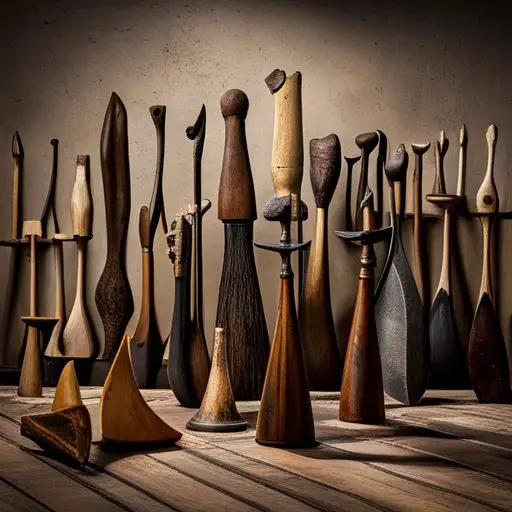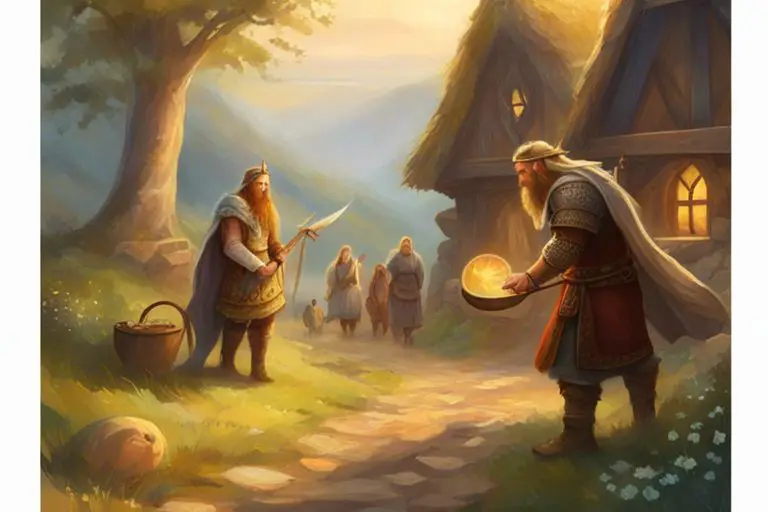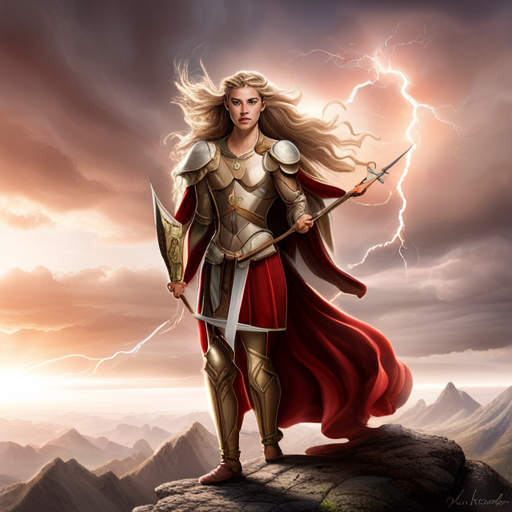I have always been fascinated by the Vikings and their way of life. The Norse people were skilled warriors, traders, and explorers who left their mark on history.
One of the most iconic and powerful weapons of the Viking Age was the battle axe, a fearsome tool that could be used for both chopping wood and splitting skulls.
In this article, I will take you on a journey through the history of the Viking battle axe, tracing its evolution from a simple tool to a deadly weapon. We will explore the different uses of axes in Norse life, the specialization of axes for combat, and the intriguing archaeological evidence that sheds light on the role of Viking battle axes in shaping history.
Join me as we uncover the secrets of the Viking axe and discover the power of these ancient weapons.
The Early Days of the Viking Age
Let’s dive into the beginnings of the Viking Age and discover the ancient secrets of a weapon that changed the course of history.
The Viking Age began in the late 8th century, and the Norsemen emerged from their Scandinavian homelands to explore, trade, and raid their way across Europe.
It was during this time that the Norse battle axe began to take shape. These early axes were simple in design, with a single blade and a straight wooden handle.
They were used primarily for chopping wood and hunting, but the Vikings soon realized that these axes could also be used as weapons.
The effectiveness of the axe in battle was undeniable, and it quickly became a weapon of choice for the Norse warriors.
Versatile Uses of Axes in Norse Life
You’ll discover how the sharp tool with a long handle played a crucial role in the daily activities and defense of the ancient Scandinavian communities. Axes were not just weapons for battle but also versatile tools for everyday life.
Farmers used them to fell trees, clear land, and shape wood for various purposes. They were also used for hunting wild animals, processing meat, and preparing firewood. Axes were even used in shipbuilding, as the Vikings were known for their prowess in seafaring.
Aside from their practical uses, axes also served as symbols of status and wealth. Elaborately decorated axes were owned by the wealthy and were often passed down as family heirlooms.
Axes were an essential part of Norse culture, and their significance extended beyond their practical uses. The Norse people revered them as sacred objects, with some even believing that they held magical powers. This reverence for axes is evident in Viking mythology, where Odin, the god of war, is depicted wielding an axe as his weapon of choice.
As axes played such a vital role in Norse daily life, it’s no surprise that they were also specialized for combat. The next section will explore how the Norse people adapted their axes for battle and how this led to the evolution of the iconic Viking battle axe.
Specialization for Combat
Discovering how the sharp tool with a long handle played a crucial role in the daily activities and defense of the ancient Scandinavian communities, the Norse people adapted their axes for combat, leading to the evolution of a deadly weapon.
As the Viking Age progressed, the axe became more specialized for combat, with modifications made to the shape, size, and weight of the blade and handle. Here are three ways the Norse people specialized their axes for combat:
– Thinning out the blade: To make the axe lighter and more agile, the Norse people thinned out the blade, making it easier to swing and maneuver during battle.
– Lengthening the handle: A longer handle gave the warrior more reach, making it easier to strike from a distance and keep the enemy at bay.
– Sharpening the edge: The sharpness of the blade became even more crucial in battle, where a single blow could determine the outcome. The Norse people sharpened the edge of their axes to a razor’s edge, making it easier to penetrate armor and inflict fatal wounds.
These modifications gave the Norse people a significant advantage on the battlefield, earning them a reputation as fierce warriors.
Through archaeological evidence, we can learn more about the evolution of the Norse battle axe and the impact it had on Viking combat tactics.
Archaeological Evidence
We can learn more about how fierce Viking warriors were through the artifacts they left behind, providing tangible evidence of their combat tactics and the modifications made to their weapons.
Archaeological evidence has shown that Viking battle axes were not just simple tools, but were designed for maximum efficiency in combat. The axe heads were shaped to inflict maximum damage, with sharp edges that could easily penetrate armor and helmets. In addition, the shape of the handle was modified to provide a secure grip, allowing for better control and maneuverability during battle.
The Vikings also added specialized features such as a spike on the back of the axe head, used for thrusting and hooking enemy shields. These modifications allowed the Vikings to use their battle axes in a variety of ways, making them one of the most versatile weapons of their time.
As we delve deeper into the history of Viking battle axes, we come to understand their crucial role in shaping history. These weapons were not just tools of war, but symbols of Viking power and dominance. They were used to conquer new lands, expand territories, and establish dominance over rival tribes.
The evolution of the Viking battle axe tells a story of innovation, adaptation, and progress, providing insight into the mindset and tactics of one of the most feared warrior cultures in history.

The Role of Viking Battle Axes in Shaping History
The crucial role played by these powerful weapons in shaping the course of history is evident in the modifications made to them, which allowed Viking warriors to conquer new lands and dominate rival tribes.
The Viking battle axe wasn’t just a tool of war, but a symbol of power and prestige. It was a weapon that struck fear into the hearts of enemies and inspired awe in allies.
The design of the battle axe underwent significant changes over time, reflecting the evolving needs of Viking warriors and the changing nature of warfare.
As Viking society expanded and became more complex, so too did the weapons they used. The battle axe evolved from a simple tool used for farming and hunting to a deadly weapon used to conquer and dominate.
The Viking battle axe was a key factor in the success of Viking raids, allowing warriors to quickly and efficiently dispatch their enemies. It was a weapon that represented both the strength and the sophistication of Viking society, and its influence can still be seen today in the many different variations of battle axes used in modern warfare.
Frequently Asked Questions
What other weapons did Vikings commonly use in addition to battle axes?
Wow, the Vikings were a fierce bunch! They commonly used swords, spears, and bows and arrows in addition to their infamous battle axes.
They were skilled in hand-to-hand combat, and their weapons were designed for maximum damage and efficiency. The Vikings were a proud and powerful people, and their weapons were a reflection of their strength and determination.
It’s no wonder they were so feared by their enemies! As a fan of history, I find it fascinating to learn about all the different weapons that were used in battle during this time period. It really helps me to feel a sense of connection to the past and the people who lived during those times.
How did Vikings learn to craft their axes and what materials were used?
Crafting Viking battle axes was a skill passed down from generation to generation, and it was integral to Norse society.
The Vikings used a variety of materials to make their axes, including iron, steel, and sometimes even bronze. The process of making an axe was a complex one, involving many different steps and tools.
First, the metal had to be heated and hammered into shape, then it was sharpened and polished. The handle was made from wood, usually ash or birch, and was carefully crafted to fit the axe head.
Learning to make a Viking battle axe was a rite of passage for young men in Norse society, and it was a mark of skill and honor to be able to create a weapon that was both beautiful and deadly.
Were there any significant differences in the design and use of battle axes between Viking regions?
As I delved into the world of Viking battle axes, I couldn’t help but wonder if there were any significant differences in design and use between the various regions.
And the more I researched, the more I realized that just like the Vikings themselves, their axes were as diverse as they were formidable. It’s like comparing the different personalities of siblings within a family – while they share common traits, each one has their own unique flair.
From the double-bladed axes of the Danes to the single-edged ones favored by the Swedes, and the elaborate inlay work of the Norwegian axes, each region had their own distinct style. Despite the differences, however, all of these axes were crafted with the same purpose in mind – to strike fear into the hearts of their enemies and emerge victorious on the battlefield.
How did the use of battle axes change as Vikings encountered new cultures and technologies during their travels?
As I delved deeper into the world of Viking battle axes, I couldn’t help but wonder how these weapons evolved over time.
As the Vikings traveled to new lands and encountered different cultures and technologies, it’s no surprise that their use of battle axes would change as well.
It’s fascinating to see how the Vikings adapted their weapons to suit their needs, from the double-edged axes used for hand-to-hand combat to the single-edged axes used for throwing.
And as they encountered enemies with armor, they began to incorporate more pointed spike-like blades to penetrate the armor.
It’s clear that the Vikings were always evolving and adapting their tactics and weaponry to stay ahead of their enemies, making their battle axes a true testament to their ingenuity and resourcefulness.
Are there any modern-day applications for Viking battle axe design and techniques?
When it comes to modern-day applications of Viking battle axe design and techniques, it’s interesting to note that there has been a rise in popularity of axe throwing as a sport.
According to the World Axe Throwing League, there are now over 200 axe throwing venues worldwide, with the number continuing to grow.
Many of these venues use axes that are inspired by Viking designs, and the techniques used by axe throwers often involve similar movements to those used in Viking combat.
It’s a fun way to connect with the past while also enjoying a thrilling activity in the present.
Conclusion
Well, after delving deep into the history of Viking battle axes, I’m left with a newfound respect for these weapons and the people who wielded them.
It’s fascinating to see how the axe evolved from a tool used in everyday Norse life to a specialized weapon for combat. It’s almost like watching a caterpillar transform into a beautiful butterfly – except in this case, it’s more like watching a lumberjack’s tool become a fearsome instrument of war.
One thing that really struck me was how much of an impact Viking battle axes had on shaping history. From legendary battles to raids that changed the course of empires, these weapons played a significant role in shaping the world we know today.
It’s amazing to think about how something as simple as a tool could have such a profound impact on the course of history. It really makes you wonder what other seemingly insignificant things might have played a role in shaping our world.





